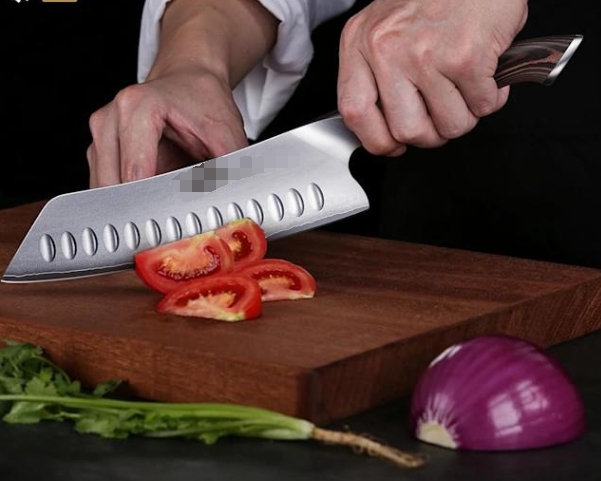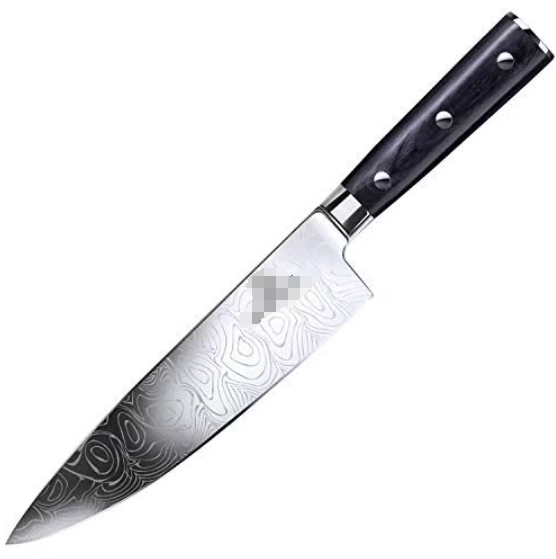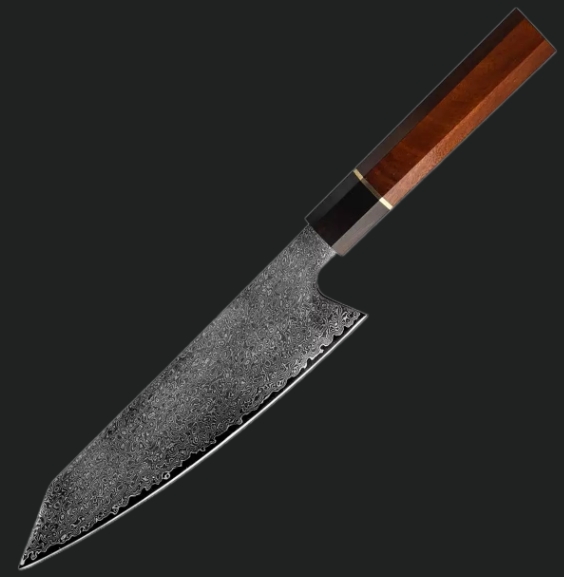

Views: 222 Author: Ella Publish Time: 2025-04-17 Origin: Site








Content Menu
● Understanding the Nakiri Knife
>> Key Features of Nakiri Knife
>> Advantages of Nakiri Knife for Vegetables
>> Limitations of Nakiri Knife
● Understanding the Chef Knife
>> Advantages of Chef Knife for Vegetables
>> Limitations of Chef Knife for Vegetables
● Nakiri Knife vs Chef Knife: Side-by-Side Comparison
● How to Use Each Knife for Vegetables
● Which Knife Is Better for Vegetables?
● Frequently Asked Questions (FAQ)
>> 1. What is the main difference between a Nakiri and a Chef knife?
>> 2. Can a Nakiri knife be used for cutting meat?
>> 3. Which knife is easier for beginners to use for vegetables?
>> 4. How do I maintain the sharpness of my Nakiri or Chef knife?
>> 5. Is it worth owning both a Nakiri and a Chef knife?
When it comes to preparing vegetables in the kitchen, the choice of knife can significantly impact your efficiency, precision, and enjoyment. Two popular knives often compared for vegetable prep are the Chef Knife and the Nakiri Knife. Each has unique characteristics, advantages, and ideal uses. This comprehensive guide will explore their differences, benefits, drawbacks, and help you decide which knife suits your vegetable cutting needs best.

The Nakiri knife is a traditional Japanese vegetable knife, instantly recognizable by its thin, rectangular blade with a flat edge and squared-off tip. It typically measures between 6.5 to 7 inches in blade length and is designed specifically for chopping vegetables with an up-and-down motion rather than a rocking cut[1][16].
- Blade Shape: Straight edge with a flat profile, allowing the entire blade to contact the cutting board.
- Blade Thickness: Thin blade designed to slice cleanly through vegetables without crushing.
- Blade Tip: Squared or rounded tip, not pointed.
- Weight: Lightweight, usually lighter than chef knives.
- Bevel: Often double-beveled, suitable for both right- and left-handed users.
- Handle: Ergonomic handles designed for comfort during repetitive chopping[6][17].
- Precision and Uniformity: The flat blade ensures even, clean cuts, ideal for slicing leafy greens, carrots, cucumbers, and other vegetables[2][9].
- Efficient Cutting Motion: The straight edge promotes a simple push-chop motion, eliminating the need for a rocking technique, which is easier for beginners and speeds up prep[3][16].
- Minimal Bruising: The thin blade reduces damage to delicate vegetables and herbs, preserving flavor and appearance[9].
- Knuckle Clearance: The wide blade provides ample space between the cutting board and your knuckles, allowing you to stack vegetables higher and work safely[16].
- Lightweight and Comfortable: Easier to handle for long chopping sessions or for those with smaller hands[1][10].
- Not Suitable for Meat or Detailed Cuts: The lack of a pointed tip makes it difficult to perform tasks like deboning or intricate incisions[8][17].
- Less Versatile: Primarily designed for vegetables; using it for other kitchen tasks is not ideal[5][18].
- Heavier Blade Surface: Some find the broad blade less agile for fine cuts compared to slimmer knives[8].
A Chef knife is a versatile Western-style knife, typically 8 inches long, with a curved blade that facilitates a rocking motion during cutting. It is designed for a wide range of kitchen tasks, including chopping vegetables, slicing meat, mincing herbs, and more[1][5].
- Blade Shape: Curved blade allowing rocking cuts.
- Blade Length: Usually between 6 to 10 inches.
- Blade Thickness: Thicker than Nakiri, designed for durability and versatility.
- Blade Tip: Pointed tip for piercing and detailed cuts.
- Weight: Heavier than Nakiri knives, providing leverage for tougher tasks.
- Handle: Ergonomic and balanced for extended use[5][19].
- Versatility: Can handle vegetables, meat, fish, and herbs, making it a multi-purpose tool in the kitchen[5][19].
- Leverage and Control: The curved blade and weight make cutting through tougher vegetables and meats easier[5].
- Precision for Detailed Tasks: The pointed tip allows for intricate cuts and decorative work[5].
- Widely Available: A staple knife for most cooks, suitable for beginners and professionals alike[7].
- Less Efficient for Straight Cuts: The curved blade requires a rocking motion, which can be less efficient for uniform vegetable slicing compared to the Nakiri's flat blade[1][16].
- Heavier and Larger: Can be cumbersome for delicate or prolonged vegetable prep[19].
- Potential for Crushing: The thicker blade may bruise delicate vegetables if not handled carefully[9].
| Feature | Nakiri Knife | Chef Knife |
|---|---|---|
| Blade Shape | Straight, flat edge with squared tip | Curved edge with pointed tip |
| Blade Length | 6.5 - 7 inches | 6 - 10 inches |
| Cutting Motion | Up-and-down push chop | Rocking motion |
| Primary Use | Vegetables and herbs | Multi-purpose (vegetables, meat, fish) |
| Weight | Lightweight | Heavier |
| Precision | High for vegetables | Moderate, versatile |
| Ease of Use | Beginner-friendly | Requires some skill for rocking cuts |
| Knuckle Clearance | Excellent | Moderate |
| Versatility | Limited to vegetables | Very versatile |
| Best For | Uniform slicing, delicate veggies | All-around kitchen tasks |

- Hold the handle firmly with your dominant hand.
- Use a straight up-and-down chopping motion.
- Let the thin, sharp blade glide through vegetables like cabbage, carrots, and zucchini.
- Stack vegetables higher on the cutting board for efficient chopping without knuckle contact.
- Avoid rocking; the flat blade should stay in contact with the board during cuts[3][10].
- Grip the handle securely.
- Use a rocking motion, where the tip remains in contact with the board while the heel moves up and down.
- Ideal for chopping, dicing, and mincing a variety of vegetables.
- Use the pointed tip for intricate cuts or piercing tasks.
- Suitable for tougher vegetables and multi-tasking in the kitchen[4].
The answer depends on your cooking style, needs, and preferences:
Choose a Nakiri Knife if:
- You primarily prepare vegetables and want precision, speed, and uniformity.
- You prefer a lightweight, easy-to-use knife with minimal learning curve.
- You value clean cuts that preserve the texture and flavor of delicate produce.
- You want to avoid the rocking motion and prefer push chopping.
Choose a Chef Knife if:
- You want a versatile knife that can handle vegetables, meats, and other kitchen tasks.
- You are comfortable with or want to learn the rocking cut technique.
- You need a single knife to perform multiple functions.
- You often cut tougher vegetables or require detailed cuts.
In many kitchens, these knives complement each other rather than compete. Having both can enhance your efficiency and enjoyment in the kitchen, using the Nakiri for vegetable prep and the Chef knife for everything else[1][5][20].
Both the Nakiri and Chef knives have their distinct places in the kitchen, especially when it comes to vegetable preparation. The Nakiri knife excels at precise, uniform vegetable chopping with a simple up-and-down motion, minimizing bruising and maximizing efficiency, making it an excellent choice for vegetable lovers and those who want dedicated tools. On the other hand, the Chef knife offers unmatched versatility, capable of handling vegetables, meats, and herbs with ease, thanks to its curved blade and pointed tip.
For home cooks and professionals alike, the best approach is to view these knives as complementary rather than competing. Starting with a quality Chef knife is practical, but adding a Nakiri knife can elevate your vegetable prep, especially if you work with vegetables frequently or want to refine your cutting technique.

The Nakiri has a straight, flat blade designed specifically for chopping vegetables with an up-and-down motion, while the Chef knife has a curved blade suited for rocking cuts and versatile kitchen tasks including meat and herbs[1][15].
While possible, Nakiri knives are not ideal for meat due to their lack of a pointed tip and thinner blade. Chef knives or specialized meat knives are better suited for cutting meat[17][18].
The Nakiri knife is generally easier for beginners because its straight blade requires only a simple chopping motion without the need for mastering a rocking technique[3][9].
Regular honing with a honing steel and periodic sharpening with a whetstone or professional service will keep both knives sharp. Avoid cutting hard materials like frozen foods or bones to prevent chipping[16].
Yes, owning both allows you to use each knife for its strengths—Nakiri for efficient vegetable prep and Chef knife for versatile kitchen tasks—enhancing your overall cooking experience[1][14][20].
[1] https://madeincookware.com/blogs/nakiri-vs-chef-knife
[2] https://yakushiknives.com/blogs/yakushi-blog-all-thing-knives/is-a-nakiri-knife-worth-it
[3] https://www.youtube.com/watch?v=8rFpcnndugI
[4] https://www.youtube.com/watch?v=ZaMbMCHKcU8
[5] https://lifebymikeg.com/blogs/all/decoding-the-kitchen-nakiri-knife-vs-chef-knife-showdown
[6] https://www.dalstrong.co.uk/blogs/chef-blog/what-is-a-nakiri-knife
[7] https://rydaknives.com.au/blogs/news/vegetable-knife-vs-chef-knife-understanding-the-differences
[8] https://jikkocutlery.com/blogs/others/nakiri-vegetable-knives
[9] https://rydaknives.com.au/blogs/news/guide-to-japanese-knives-santoku-vs-nakiri-vs-classic-chef-knife
[10] https://www.youtube.com/watch?v=JHp04zcSbMw
[11] https://www.youtube.com/watch?v=p28wMbunulQ
[12] https://www.dalstrong.co.uk/blogs/chef-blog/facts-you-need-to-know-about-the-nakiri-knife
[13] https://cookingpanda.com/blogs/food-news/how-to-use-a-vegetable-knife
[14] https://www.reddit.com/r/chefknives/comments/dvm3n1/nakiri_vs_a_chefs_knife/
[15] https://kyokuknives.com/blogs/kyoku-chef-blog/japanese-nakiri-vs-chef-knife
[16] https://sharpedgeshop.com/blogs/knife-types/nakiri-the-knife-for-cutting-vegetables
[17] https://kazsknifeonline.com.au/blogs/knife-knowledge-and-information-1/nakiri
[18] https://katto.shop/blogs/toast-our-blog/what-is-a-nakiri-knife-and-why-do-you-need-one
[19] /the-ultimate-showdown-vegetable-knife-vs-chef-s-knife.html
[20] https://www.thecookingguild.com/blogs/news/nakiri-vs-chef-vs-santoku-vs-bunka
[21] https://www.youtube.com/watch?v=9Wdto78bqa4
[22] https://madeincookware.com/blogs/knife-to-cut-vegetables
[23] https://www.knivesandtools.com/en/ct/buying-guide-vegetable-knives.htm
[24] https://rydaknives.com.au/blogs/news/guide-to-japanese-knives-santoku-vs-nakiri-vs-classic-chef-knife
[25] https://rydaknives.com.au/blogs/news/vegetable-knife-vs-chef-knife-understanding-the-differences
[26] https://us.santokuknives.co.uk/blogs/blog/which-is-best-santoku-vs-nakiri-let-the-battle-commence
[27] https://www.seriouseats.com/best-nakiri-knives-6931056
[28] https://www.reddit.com/r/chefknives/comments/qzzq71/whats_the_advantage_of_a_nakiri/
[29] https://katto.shop/blogs/toast-our-blog/what-is-a-nakiri-knife-and-why-do-you-need-one
[30] https://kakushin.ca/blogs/blogs/top-3-pros-and-cons-of-japanese-kitchen-knives
[31] https://www.foodandwine.com/best-vegetable-knives-8400300
[32] https://www.youtube.com/watch?v=EVBM-b_Mx4M
[33] https://www.youtube.com/watch?v=rvMhznbrNmI
[34] https://www.reddit.com/r/Cooking/comments/1i908fv/chef_knife_vs_vegetable_knife/
[35] https://www.youtube.com/watch?v=OH3czHJdeSE
[36] https://www.youtube.com/watch?v=MKaLbBYGhfY
[37] https://www.kitchenknifeforums.com/threads/vegetable-cleaver-vs-nakiri.39124/
[38] https://www.youtube.com/watch?v=EJUjTrUCnHE
[39] https://www.tiktok.com/@communitycutlery/video/7484576450159332630
[40] https://syosaku-japan.com/blogs/default-blog/nakiri-knife-1?page=4
[41] https://www.reddit.com/r/chefknives/comments/dvm3n1/nakiri_vs_a_chefs_knife/
[42] https://sharpedgeshop.com/blogs/knife-types/nakiri-vs-santoku-choosing-the-right-japanese-knife-for-your-kitchen
[43] https://www.chefknivestogoforums.com/viewtopic.php?t=14619
[44] https://www.knivesandtools.com/en/ct/vegetable-knives.htm
[45] https://www.reddit.com/r/chefknives/comments/o69tka/nakiri_and_usuba_questions/
[46] https://www.dalstrong.co.uk/blogs/chef-blog/vegetable-knife
[47] https://www.kitchenknifeforums.com/threads/hot-take-does-anyone-actually-use-a-nakiri.63380/
[48] https://elementknife.com/pages/common-questions-about-kitchen-knives
[49] https://www.thebambooguy.com/blogs/kitchen-knives/frequently-asked-questions-about-kitchen-knives